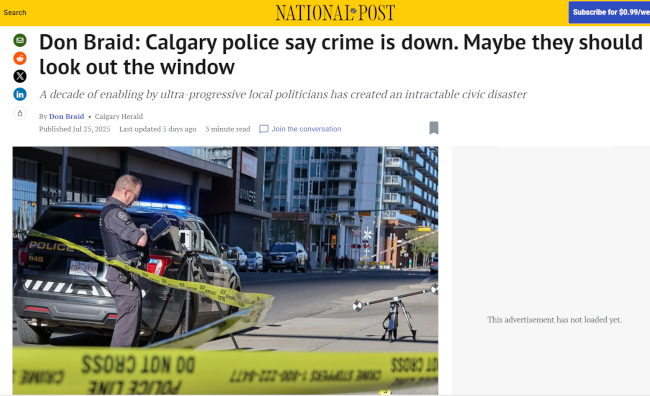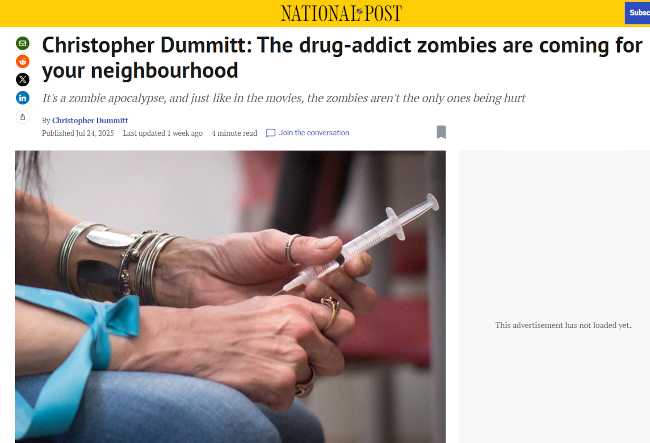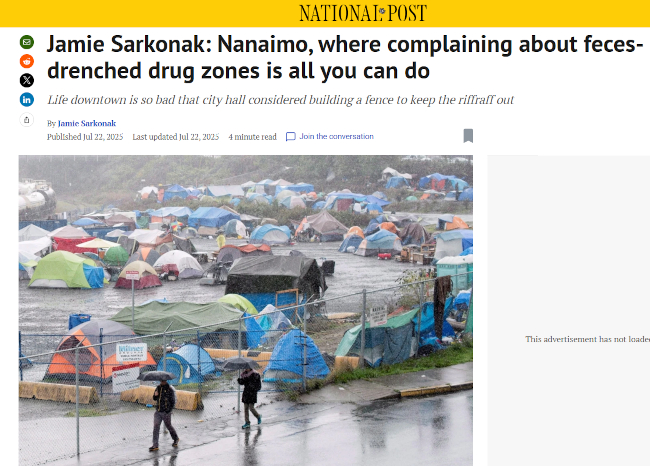
Reflections on Vancouver, British Columbia and other topics, related or not
Canada’s urban shitholes:
the Alberta version
A wasteland even before drugs arrived,
Calgary disproves all the usual excuses
for underclass dysfunction
Greg Klein | July 31, 2025
Three recent National Post features might indicate an ongoing survey of squalid Canadian cities. Quite appropriately the first was Nanaimo, a once near-idyll that rapidly achieved shithole status in 2017 (unacknowledged by the NP) with a poverty pimp-organized junkie invasion. The NP series followed with a B.C.-like account of Peterborough (read an excerpt), then Calgary.
The Albertan effort comes from Don Braid, a Calgary Herald columnist who used to cover topics like driving in mildly congested traffic and shovelling snow. So if Braid now recognizes a Calgary problem that was manifest in the mid-1990s, others must recognize it too. That shows urban decline has spread beyond downtown, which Calgarians have long considered a no-go zone as much as possible Monday to Friday daytime and absolutely after 5:45 p.m. and on weekends.
Downtown avoidance has probably always been a factor in Prairie cities and towns due to native behaviour. Out of sight and out of mind, downtown dysfunction hadn’t previously penetrated Cowtown complacency, a media booster spirit that celebrated a generally dull city, inexcusable public transit, amazingly misguided urban planning and an inexplicable delusion that the city is located “in the mountains!” (Under clear weather, from a few high points of land, the Rockies can be seen on the horizon.) Oddly enough, media boosterism co-existed with a mean, miserable aspect that helps characterize Albertans.
Maybe Braid recently was almost mugged by reality. He mentions a pair of creeps trying to grab his wife’s purse. But very aggressive, sometimes violent panhandling was rife in downtown Calgary throughout the 1990s and probably earlier. Persistent, often angry demands for money originally came from natives, then became a bi-racial problem around 1997. That’s when the practice exploded as Calgary became inundated with native and white street people.
An important lesson demonstrated in ’90s Calgary, though, was that vast underclass expansion came first, and during a time when jobs and affordable apartments were available. Widespread drug use came later.
While Braid was documenting suburban trivia, those who ventured downtown (necessary to make transit connections) were subject to extremely aggressive demands for money that could include violence. The Herald did report some of this, but without mentioning “panhandling,” “begging” or outright demands for handouts. Buried within stories about downtown assaults would be brief mention that the perps had been “asking” for money or cigarettes. One such story showed a CTrain station surveillance photo of an airborne native stomping an Asian man into a coma.
Around 1998 or ’99 the downtown business owners’ association started a campaign to discourage people from giving money to panhandlers. Braid’s paper reported the campaign without asking its reason, let alone acknowledging the related crime wave.
Around that time one probably well-connected restaurateur got permission to allow customers to drive right up to his place on Calgary’s otherwise pedestrian-only Stephen Avenue. Patrons had to walk just a few steps across the sidewalk to the restaurant door while a valet parked the car elsewhere. Even then, the Herald reported, staff had to call cops several times a night because of all the harassment experienced in that very short distance. The paper didn’t mention what kind of harassment.
That shit was happening in Vancouver too, but I’d been away for a long time. Naively aghast at Calgary, I naively wrote letters. The police chief responded that Calgary did not have a panhandling problem. On the other hand a city councillor phoned to say that before someone else corroborated my remarks she initially disbelieved me. (Calgary City Hall’s secure underground parking protects council members and staff from the outside world.) But she went on to say all panhandlers are mentally ill.
A similar explanation for all street life can come from B.C. Liberal leftovers in the B.C. Conservatives, who’ll sometimes consider insane anyone who lacks a mortgage, an SUV, skis and golf clubs. B.C.’s NDP had previously toyed with the insanity excuse before banning it due to the party’s failure to improve mental health care, an especially touchy subject after Lapu Lapu.
Back in the ’90s Calgary panhandlers didn’t look crazy to me. That was before psychosis-inducing street drugs really took hold in Alberta. Most Alberta street people were run-of-the-mill native and white Canadians, just more fucked up. Some of the whites typified guys I’d known while toiling at unskilled jobs. Nostalgia buffs might remember that era when people were expected to work for a living and not openly break the law.
The pre-addiction state of underclass denizens can include incoherence, confusion and utter stupidity but not typically schizophrenia, bi-polar disorder, multiphasic personality or any other real mental illness. Where they do exist, mental problems aren’t necessarily unmanageable. Degrees of those ailments can be present in well-functioning people.
And looking at today’s steadily increasing cases of addiction, it’s not credible to blame them on steadily increasing cases of insanity—not unless there’s something new in food, water or the environment that drives greater numbers of people to obviously dangerous drugs. Profound confusion—affecting both cognition and behaviour—likely does increase steadily, thanks to societal decline in what was already an exceedingly shallow society. In other words, Canada has more fuck-ups than ever, but they’re not always insane. At least, not before their incredibly stupid decision to take psychosis-inducing drugs.
The mental illness excuse fails, and so does poverty. The street population of late ’90s Alberta was booming but so was the economy. Any reasonably fit person could find work.
That pretty much limits excuses to “un-met housing needs.” It’s currently the B.C. NDP’s primary explanation for crime and drug addiction, and the rationale for a multi-billion-dollar expansion of B.C. Housing which will—coincidentally, of course—greatly expand NDP-supporting union membership in BCH and its housing society contractors.
But ’90s-era Calgary disproves that explanation too. Street people didn’t necessarily sleep rough. A lot of them had cheap digs but took on the look, demeanor and image of the street lifestyle. Calgary apartment vacancies were rather tight but by no means unattainable, even for people on modest incomes. B.C.’s urban squalor predates this province’s shortage of affordable rents. Vancouver’s mess predates the rental squeeze by decades.
Back to Braid and his MSM-level of understanding. As he recounts,
I spoke Friday [probably July 25] to a man of great compassion who works every day with the homeless and addicted on the streets.
He says that years ago, poverty, mental illness, chronic pain, homelessness, childhood abuse and lack of supports suddenly collided with fentanyl, meth and various concoctions of enormous destructive power.
At that point, “it just turned into a tornado,” he says.
Yeah, the drugs got more dangerous, thanks to Canadian concepts of law enforcement. No one in Canada’s Enlightened class wants anything more than bail reform.
At one time chronic pain was a contributing factor to junkiedom, but that was when doctors over-prescribed opioids. As for child abuse, has it really become that common or does the term now refer to unhappy childhoods? Mental illness, poverty and homelessness? Too bad the driving and shovelling correspondent wasn’t paying attention all those years ago.
That leaves “lack of supports.” Here in B.C. “supports” not only means free homes and income for life but more social workers, salaried social justice phonies, 24/7 babysitters and others in the NDP-boosting unions. In B.C. it also means inducements to a lifestyle that’s incredibly stupid but wildly self-indulgent for its followers, profitable for poverty pimps and power-enhancing for the NDP.
Just as Calgary provides one lesson, poor little Nanaimo offers another. This is the near-idyll that suddenly became a junkie nirvana eight years ago. City council has recently been discussing street crime to offset the embarrassment of a staff request to build a nearly two-metre-high, wrought-iron fence to protect City Hall and its outdoor parking lot from “highly vulnerable people” carrying “bear spray, knives, brass knuckles and firearms.” Led by cynical old Dogpatch demagogue Leonard Krog, most councillors express vacillating concern while making excuses to do nothing.
Contrasting with Braid’s encounter with reality, Nanaimo council’s most adamant advocate of junkie inducements remains un-muggable. Months after Hilary Eastmure moved out of her previous apartment building, it was hit by a “suspicious” fire that had to be deliberate. Firefighters rescued a wheelchair-bound resident within five minutes of “something awful.” Damage to her apartment displaced her for four months. Four vehicles were destroyed.
Most likely the fire was part of an ongoing trend of arsons that’s been underway in Nanaimo, Victoria, Vancouver and other places since at least 2023. It’s a category apart from accidental fires set by campers, squatters and passed-out junkies, and seems to be motivated by underclass resentment.
Much like the 1990s Calgary Herald approach to stories about panhandling-related assaults, B.C. media will report individual cases of arson without acknowledging the ongoing trend. (Still naive after all these years, I’ve written about this to editors and senior reporters at the National Post, Vancouver Postmedia and Victoria Times Colonist. Of course the effort was futile.)
The arson trend constitutes just one more symptom of Canada’s new normal barbarity. Destructive and violent activity is perpetrated by an incredibly stupid, confused and aggrieved underclass, egged on by opportunistic social justice phonies, and encouraged by judicial leniency and tax-funded inducements.
Think any of that’s going to end? Think Rustad’s and Poilievre’s slightly different parties even understand that?
Postscript
People of power or influence who hate normality (quite common in Western elites) can now use the Trump card to justify urban breakdown. They can associate any proposal to clean up Canadian cities with Satan Incarnate.
The American president has ordered a crackdown on the “endemic vagrancy, disorderly behavior, sudden confrontations, and violent attacks [that] have made our cities unsafe.” In doing so he announced a number of measures intended to move homeless people into (gasp!) “long-term institutional settings for humane treatment.”
Trump—what better excuse to reject common sense.


